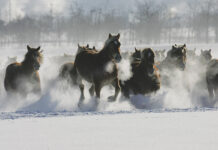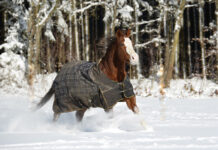 |
| Western pleasure and showmanship classes are typically the most demanding in terms of turnout and presentation. Photo: Sharon Fibelkorn |
Showing your western performance horse isn’t only about exhibiting his talent and training. It’s also about how you present him in the ring. He needs to follow the current standards to look like he belongs and give an outstanding impression every time he passes in front of the judge.
Preparation
On the day before the show, bathe and clip your horse. It’s best to clip your horse before you bathe him, but if his legs are dirty give them a scrub and a rinse and then let them dry. If you don’t, the clippers will leave track marks and the blades will gum up. The long hairs on the backs and inside of your horse’s legs from the knees down should be removed. If your horse has white socks or stockings, clip the white against the hair with a coarse blade. Trim the hairs that hang over his coronet bands, too. On your horse’s face use a fine blade to remove the long hairs all around his muzzle and chin. With a coarser blade, trim down the guard hairs above and below his eyes, but take care to avoid cutting his eyelashes. You’ll also use the fine blade to clean out the hair inside your horse’s ears and a slightly coarser blade to trim around the edges. For stock breeds, such as Quarter Horses, trim your horse’s bridle path 2 to 4 inches back from the poll.
After clipping, bathe your horse with a conditioning shampoo that doesn’t strip the natural oils in his coat. Pay special attention to getting his whites as white as they can be, and make sure his mane and tail are clean to the base and tangle-free. Once your horse is clean, scrape off any excess water and mist your horse with a conditioning spray to replace oils and add sheen to his coat. A silicone based spray over that will repel dirt and also can also help with tangles. Take care not to spray the saddle or girth area so that your saddle doesn’t slip. Don’t spray his mane either, because it will make it harder to band.
Mane and Tail
 |
| Banding your horse’s mane will give him a cleaner topline. Photo: Leslie Potter |
If you are showing an Arabian, Morgan, Saddlebred, or gaited horse, you will typically leave the mane at its full length. For stock horse breeds such as Quarter Horses, Paints and Appaloosas, the mane will need to be shortened to the proper length for banding. Leaving it a little longer can make a thicker neck look better, and a shorter mane will add depth to a thin neck. Shortening your horse’s mane can be done a few days before the show. Banding needs to be done after your horse’s bath and can be done the day before the show. Separate out small sections of mane, about a half inch wide. Dampen the section of mane that you are working. Separate out a section to be banded and use a hair clip to hold the rest out of the way. Pull the hair flat and tight toward you across the crest of the mane. Position so the band at the edge of the crest so that when you tighten it it holds the mane down and and flat across the top. Retighten any bands that come loose before your classes and apply a thin coat of hair gel to hold down any stragglers. Band your horse’s forelock too so that it lies flat against his forehead. Use a very light coat of gel or conditioner to keep it looking neat and quiet without making it look stiff or clumpy.
Your horse’s tail should be banged, or cut straight across at the bottom. Hold your horse’s tailbone in the position of his natural carriage a couple in inches away from his body this so that it looks straight when he’s moving. If your horse’s tail is short or on the thin side, use a tail extension to give it a fuller and longer appearance. Not all breeds allow tail extensions, and some have restrictions on what type of tail extension you can use. Be sure to check your rule book.
Finishing Touches
On show day, clean any dirt that your horse accumulated during the night. Use a safety razor or muzzle shaver to clean up the stubble on his nose and chin. Scrub his hooves with the scrubber side of a sponge and soap and water if necessary. If your horse has any white hair on his legs, rub in white chalk or baby powder for added brightness. When his hooves are clean and dry, apply hoof oil or polish. Make sure you do this after whitening your horse’s legs to avoid making his hooves white, too. A coat of black hoof polish or clear lacquer gives your overall looks a glamorous finishing touch. Just make sure that the product you use is legal for your breed or association. For example, Appaloosas are only shown with clear polish to emphasize their natural hoof coloration and Arabians are shown without hoof black as well.
Put baby oil or face highlighter on a towel and rub it into your horse’s muzzle, around his eyes, and the inside of his ears. Apply a thin mist (to prevent streaking) of coat spray and fly spray. Before you go into the ring, use a clean brush or towel to wipe down your horse’s coat. Brush out his tail and make sure all his bands are tight and flat. Wipe off his hooves, around his lips, inside his nostrils, and around his eyes. Remove any remaining dust with a towel that’s lightly dampened with a spray of alcohol.
Give your horse a final visual once-over and then you can enter the ring knowing that your horse looks dazzling and ready to impress.
Further Reading
How to Band a Western Horse’s Mane
Grooming for Halter and Showmanship
See all course materials






Interesting article, but it could have been written better–there were quite a few mistakes.
I feel that any genuine cowboy would be bewildered by modern western pleasure horse shows. Funny how ‘cowboy tradition’ based things have gotten so glitzy and glamorous.
There really are too many mistakes in this article. Especially for a college course! Great information for those showing Western though.
This article presanted good information. I always thought that there wasn’t much difference between a Rodeo and a Western Show. Now I know.
great information !!!